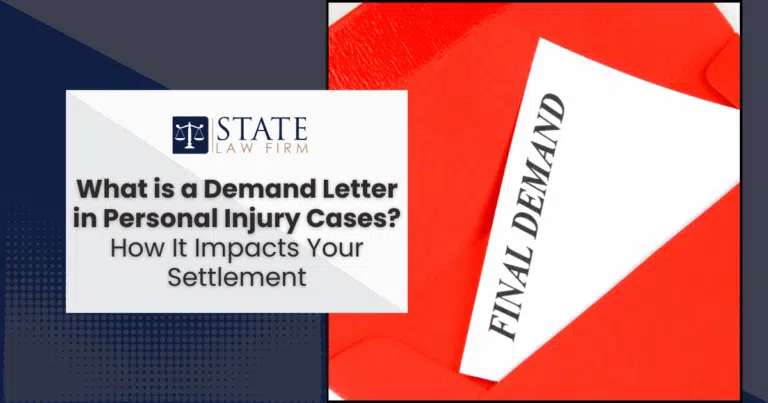When you’ve been injured due to someone else’s negligence, one of the first strategic tools your attorney may use to help you recover compensation is a demand letter. This seemingly simple document often lays the foundation for your entire personal injury claim, opening the door to settlement negotiations before a lawsuit is even filed.
According to the U.S. Department of Justice, nearly 95% of personal injury cases are resolved through settlements rather than trial, highlighting just how critical strong pre-litigation advocacy, like a well-crafted demand letter, can be in achieving a favorable outcome for injured clients. (Bureau of Justice Statistics).
At State Law Firm’s Sherman Oaks office, our attorneys pride themselves on helping clients navigate the legal process with confidence and clarity. We’re a boutique firm run by young litigators who are fiercely committed to building compelling cases from day one. Whether you’re dealing with a car accident, slip and fall, or another personal injury claim, understanding how demand letters work—and how to make them work for you—is essential.
In this article, we’ll walk you through what a demand letter is, why it matters in personal injury law, how to draft one effectively, and what to expect once it’s sent. Consider this your guide to one of the most powerful tools in your legal arsenal.
Understanding the Basics of a Demand Letter
A demand letter is a formal written request sent to the at-fault party (or their insurance company) outlining the details of a personal injury claim and the compensation being sought. In personal injury law, this letter serves not only as notice of your intent to pursue legal action but also as an opportunity to resolve the case before a lawsuit is filed.
Whether it’s for a car crash, a slip and fall, or any negligence-based incident, a personal injury demand letter typically includes:
- A clear description of how the injury occurred
- A breakdown of damages (medical bills, lost wages, pain and suffering, etc.)
- Evidence supporting your claim
- A specific dollar amount is being demanded
- A deadline for the recipient to respond
Think of the demand letter as your first major opportunity to tell your story on your terms—and to do it with legal strength behind you.
The Importance of a Demand Letter in Personal Injury Claims
A well-prepared demand letter can significantly impact the outcome of your case. It frames your narrative, compellingly presents the facts, and encourages early negotiation. In many cases, it’s the demand letter, not the complaint, that sets the tone for settlement discussions.
Why it matters:
- Initiates negotiations: Insurance companies often won’t consider paying a claim until a demand letter is received.
- Establishes professionalism: A structured, lawyer-drafted letter shows you’re serious.
- Serves as legal documentation: It becomes part of the case record and can be referenced later if negotiations break down.
- Creates leverage: A strong letter increases the likelihood of a fair initial offer or faster resolution.
Pro Tip: Include a detailed summary of your medical treatment and attach all supporting documentation—doing so builds immediate credibility.
Key Components of an Effective Demand Letter
There’s no room for fluff here. Every section of your demand letter should serve a strategic purpose. The most effective demand letters generally include:
- Introduction & Liability Statement
Clearly state who was at fault and why. This is your chance to establish the defendant’s negligence right away. - Description of the Incident
A timeline of events supported by facts, police reports, and witness accounts. - Injury Summary & Medical Treatment
Detail your injuries, doctor visits, diagnostics, procedures, and the physical/emotional toll taken. - Damages Breakdown
Include: - Medical bills
- Lost income
- Future treatment costs
- Pain and suffering
- Demand Amount
Be specific, and explain how you arrived at the total. - Deadline for Response
Typically, a 15–30 day window signals urgency without being unreasonable.
How to Draft a Persuasive Demand Letter for Your Case
The art of persuasion isn’t about exaggeration—it’s about clarity, tone, and strategic presentation.
Here are some tips to help shape a powerful demand letter:
- Use strong but respectful language: Maintain a firm tone without being combative.
- Be specific and organized: Break the letter into digestible sections with clear headers.
- Support every claim: Attach documentation. Insurance adjusters won’t take your word alone.
- Avoid common pitfalls:
- Don’t include unnecessary personal commentary.
- Don’t demand an unreasonably high amount—this can stall negotiations.
- Don’t leave out important damages (like emotional distress or long-term care needs)
Pro Tip: Let your attorney draft and revise the letter. They know how to strike the right tone and anticipate how insurers think.
What Happens After Sending a Demand Letter?
So you’ve sent your demand letter—now what?
In most personal injury cases, here’s what typically happens next:
- Acknowledgment: The insurance company will confirm receipt.
- Review: They’ll assess the letter, review medical records, and investigate the claim.
- Response: You may receive:
- A settlement offer (sometimes lowball at first)
- A request for more information
- A denial of the claim
From here, the negotiation phase begins. Depending on the quality of the letter and the evidence provided, the other side may either move to settle or prepare for litigation. This is where having experienced legal representation makes a difference.
At State Law Firm, we don’t just send off letters and wait—we stay on top of deadlines, keep pressure on the other side, and prepare for trial in case a fair settlement doesn’t happen. That’s the kind of advocacy we believe injured people deserve.
If you’ve been injured and need help drafting or sending a demand letter, or you’re unsure whether you even have a case, our team is here to talk strategy and help you understand your options.
Explore your rights with a team that fights to win even the toughest cases.


